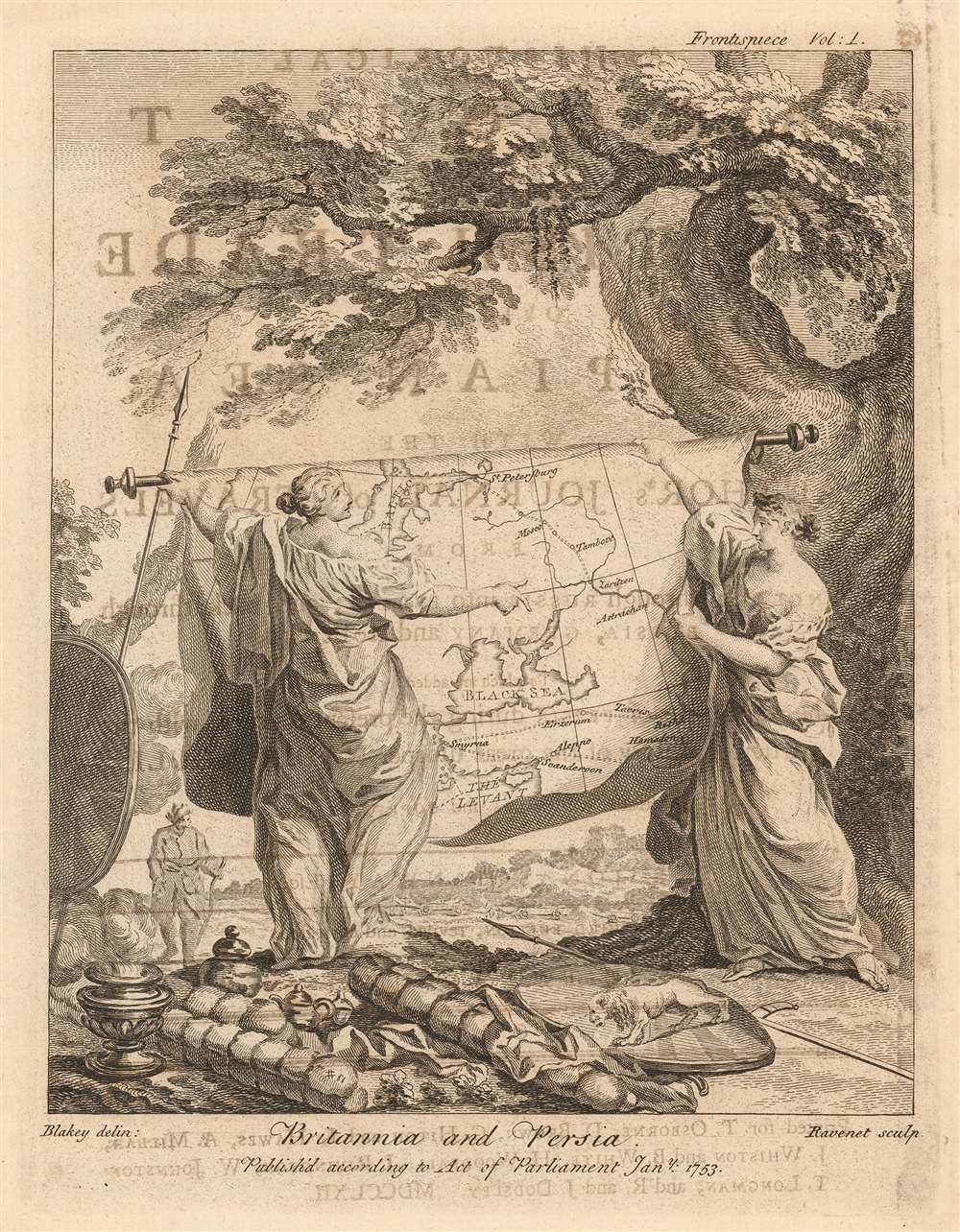1753 Jonas Hanway Allegorical Frontispiece
BritanniaPersia-ravenet-1753
Title
1753 (dated) 8.25 x 6.25 in (20.955 x 15.875 cm)
Description
Unpacking the Image
Under the shade of a tree, Britannia and Persia - depicted as classically-robed women - support a map of Russia, the Caucasus, and Asia Minor. On the map are drawn the primary trade routes used by Britain to reach the Caspian region via Asia Minor and Russia. The meeting of the two women is peaceful: they have laid their shields and spears aside. (The shields help identify the women, bearing as they do the Union Jack and the Persian Lion and sun.) At their feet are incense burners and bundles of silk, indicating the profitable trade potential. Britannia's somewhat superior manner in the image suggests she is the more knowledgeable of the two: she gestures at the map, bringing the trade routes to Persia's attention, who seems compelled by the opportunities.Publication History and Census
This illustration was drawn by Nicholas Blakey, and engraved by Simon Ravenet in 1753 for inclusion in Jonas Hanway's An Historical Account of the British Trade over the Caspian Sea. This example appeared in the third, 1762 edition of Hanway's book. We see eight examples of the complete work in institutional collections. This image has not been separately catalogued in OCLC.CartographerS
Jonas Hanway (August 12, 1712 - September 5, 1786), was an English philanthropist, traveller, and writer. He was apprenticed in 1729 to a merchant in Lisbon, but in 1743 he became partner to merchant and member of the British Russia Company Robert Dingley (1710 - 1780) who was based in St. Petersburg. This led to the travels in Russia, Central Asia, and Persia which would inform Hanway's (copious) writing on the topic of British trade in the Caspian Sea, which would earn him the attentions of scholar Charles Wilson who hailed him 'one of the most indefatigable and splendid bores of English history.' On his return to London his narrative brought him some fame and success, and thereafter he remained in the city devoted to good causes and good citizenship. He founded The Marine Society in 1756 (a charity supporting inland youths wishing to go to sea.) He was instrumental in the aid of various hospitals; arranged improvements in Londons's birth registration system; and in 1762 he was appointed a commissioner for victualling the navy. Hanway was an eccentric and a gadfly. He protested, voluminously, the English practice of tea drinking, both on the grounds of its effect on the health and on the balance of foreign trade. He was the first male Londoner to carry an umbrella. This shocking move drew the opprobrium of fellow Londoners who objected to the effeminate, French contraption, and the ire of hansom cab drivers who quite correctly identified the invention as a threat to their trade (rainstorms caused Londoners to flock to hansom cabs as a sheltered means of transport.) He died unmarried. A monument to his memory stands in Westminster Abbey, praising his works of charity. It discusses neither umbrellas nor tea. More by this mapmaker...
Simon François Ravenet (1706 - 1764) was a French engraver. He studied engraving under Jacques-Philippe Le Bas, but moved to London in 1750, where he would live and work the remainder of his life. He was an assistant to William Hogarth, and taught his art to others: his pupils included the engravers John Hall and William Wynne Ryland. His son Simon was also an engraver. Learn More...
Nicholas Blakey (? - 1758) was an Irish-born draughtsman and engraver. He specialized in book illustrations, usually on historical themes. His early life is not known, but studied in Paris at the end of the 1740s. He collaborated with several artists and engravers, including Simon François Ravenet. Blakey died in Paris in 1758. Learn More...

